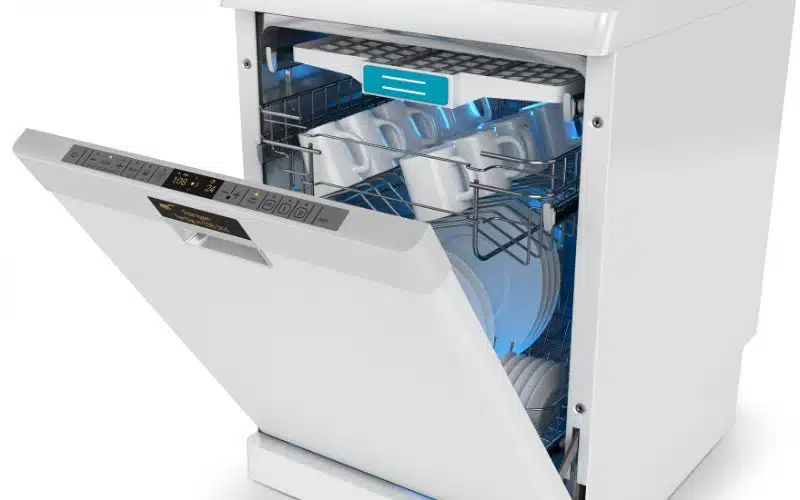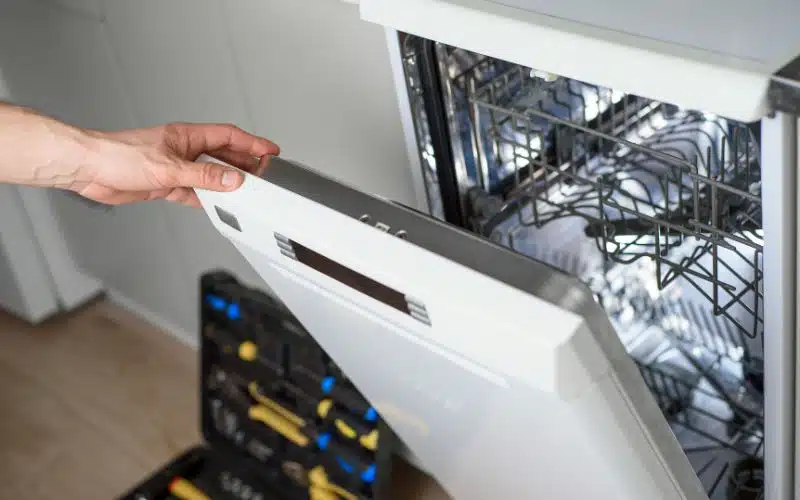The brand’s reliability is one of the most important things to consider when purchasing home appliances.
For households who make and enjoy homemade meals, a GE dishwasher is a smart move because of the brand’s reputation for the dependability and quality of its products.
Safety is essential for these appliances, which is why a thermal fuse is always present in a dishwasher.
So it is customary to wonder if the GE dishwasher has this safety device. Let’s find out.
Yes, a GE dishwasher has a thermal fuse. For example, suppose there’s a malfunction, and the dishwasher starts overheating. In that case, the thermal fuse is a safety measure to cut off the power to the heating machine, preventing fire development.
In this article, I’ll accentuate the position of the thermal fuse on your GE dishwasher, its function, how to know when it’s blown, and how to repair it.
Where Is the Thermal Fuse on a GE Dishwasher?

You can find the thermal fuse on a GE dishwasher and most dishwashers on the control board casing. A couple of locking tabs hold it down firmly on the control board.
The thermal fuse is vital and determines if the dishwasher functions. When the thermal fuse malfunctions, the control board won’t get power, and the dishwasher won’t operate.
What Is the Function of the Thermal Fuse on a GE Dishwasher?
The thermal fuse serves as a component that prevents overheating in your dishwasher and other electrical appliances that are prone to overheating.
A thermal fuse, also known as a thermal cutoff, guards against fire in machinery and electrical equipment, including the GE dishwasher.
When electrical appliance malfunctions and starts to produce heat, the thermal fuse will instantly connect to break off the power supply.
This process occurs when the temperature rises above average to stop the electrical appliance from starting a fire.
The thermal fuse’s job is to prevent the heating element from overheating or from being exposed to too much current.
Unlike electrical or regular fuses, thermal fuses only respond to excessive temperature, not to excessive current.
A thermal fuse prevents a circuit from overheating by interrupting or stopping the current when it is high. This fuse is similar to an electrical fuse, but there are also some distinctions.
Here’s a table showing the difference between a thermal and electrical fuse.
| Thermal Fuses | Electrical Fuses |
|---|---|
| It needs replacement when it overheats. | Doesn’t require frequent changes like the thermal fuse. |
| A thermal fuse mainly reacts when excess heat can damage the appliance. | Electric fuses prevent potential threats to the electrical systems, such as high currents. |
How Do You Know When the Thermal Fuse Blows on a GE Dishwasher?
The most common way to find out if the thermal fuse in your dishwasher is worn out is when it stops coming on.
You’ll need to do a continuity test because it’s impossible to identify whether a fuse has blown just by looking at it.
A continuity test will reveal whether the fuse has a continuous electrical channel. The fuse ought to be operating if there is continuity. If there is no continuity, it means the fuse has blown.
Depending on the model of your GE dishwasher, fuses come in various sizes and forms, but you can test all fuses for continuity in the same manner.
To do the test, ensure the thermal fuse is not in the dishwasher. Then, you can pick from various multimeters to test the fuse. Multimeters come in both analog and digital varieties.
For an analog model:
- Turn the range selection knob to the lowest setting for ohms of resistance.
- Clamp the probes together, and then set the needle to zero.
- To test the fuse, touch one fuse terminal with a probe and the other with a second one.
- If your meter reads resistance of zero ohms, your fuse has continuity.
- Finally, if the meter’s needle does not move, there is no continuity, meaning the thermal fuse has blown.
For the digital multimeter:
- Rotate the dial to the lowest setting for ohms of resistance.
- If the meter allows resistance with the tone, turn the dial to that position.
- In the same way as the analog meter, use both probes to touch both terminals on the fuse.
- If the meter reading indicates zero ohms of resistance, the fuse has continuity.
- There is only continuity if the digital display changes. No continuity indicates that the fuse has blown, so you must replace it.
Fuse failure frequently implies a shorted electrical component in the dishwasher, which could be the thermostat or a heating element.
There are some situations where the thermal fuse continues to blow even after changing it.
Here are some reasons why this might be happening.
#1. A Broken Wire
Your dishwasher will have a lot of cables going through it. Depending on your GE dishwasher’s model, the cables’ exact location may vary slightly. The exact positions will be in the manual.
The wires are usually insulated, but wires can occasionally break for several reasons. First, there could be a collision, which will break a section of the wire.
A broken wire can touch other exposed wires or the dishwasher’s metallic components, which might result in a short circuit.
Which heats the thermal fuse to the point where it closes the circuit to safeguard the rest of the device. When this happens, you will need to replace the thermal fuse.
If you change the thermal fuse without fixing the broken wires, you’ll keep replacing it because anytime the broken wire touches it.
There might be a short circuit that will damage the fuse again. It is easy to replace a broken wire; finding the damaged one is challenging. To do that, you’ll have to sift through each wire.
Once you locate it, you cut the broken wire and join it with a wire nut. It is advisable to keep an eye out for any further damaged cables.
#2. Error In the Temperature Sensor
The water in a dishwasher must be hot enough to efficiently remove grease and food items from the dishes inside the appliance.
And the dishwasher depends on a temperature sensor to make that happen.
When the thermostat’s temperature sensor notices that the water entering is too cold, the component will instruct the device to heat the water to a more appropriate temperature.
The temperature sensor will shut off the appliance when the water is hot enough to prevent overheating and damage.
The temperature sensor is susceptible to malfunctioning like any other dishwasher component.
The thermal fuse inside the dishwasher will blow if the dishwasher heats the water to the point of overheating.
The thermal fuse will blow to stop the circuit. Doing this will shield the dishwasher from further harm and guard against any accidents that can hurt the person using the device.
You will have to replace the temperature sensor and the thermal fuse for the dishwasher to keep working.
It is best to contact a professional to fix this, especially when you don’t know how to do it.
What Does It Cost to Replace the Thermal Fuse on a GE Dishwasher?
The cost of replacing the thermal fuse on your GE dishwasher depends on some factors. If you’re only replacing the fuse, it would cost between $80–$130 asides from the service fee.
If other components are causing the fuse to blow frequently, then there will be a need to repair or replace them. If this is the case, you will incur more costs.
You should replace the dishwasher if repairing it would cost 50% or more of the price of a new one.
Also, if you’ve had to repair your dishwasher more than once in the past year, it’s probably time to buy a new one.
Even though a costly repair now and then might be worthwhile, multiple parts failing means the appliance is malfunctioning.
It is often better to fix than replace, especially if the dishwasher is relatively new or repairs are not expensive.
How to Change the Thermal Fuse In a GE Dishwasher?
Anyone with a dishwasher may occasionally have a blown thermal fuse. Unfortunately, that is common, and changing it is relatively simple.
Here’s how to do it;
- Flip the circuit breaker to detach the dishwasher from the power supply to begin this repair.
- Ensure that the inside of the dishwasher is dry before you begin.
- Start by removing the screws holding the control panel in place. After removing it, the control panel should fold forward to access the thermal fuse.
- Now that you have access to the thermal fuse loosen the locking tabs holding the old fuse in place.
- Pull the fuse and remove it but be careful of the surrounding wires.
- Put the new thermal fuse and reconnect the wires and the locking tab.
- Screw the control panel in place and start the machine.
If this does not work or you don’t feel comfortable doing this yourself, it’s best to engage a repair company to determine the root of the problem.
FAQs
#1. Why Is My Dishwasher Not Coming On?
The GE dishwasher will only start if the door is fully closed. Electrical issues, including thermal fuse blowing and disconnected power, are a few reasons your dishwasher is not working.
#2. How Do I Reset My Dishwasher?
On the dishwasher’s control panel, try pressing the “Start/Reset” button and wait for two minutes.
If the problem persists, consider restarting your dishwasher by turning off the electricity from the fuse box for at least 30 seconds.





